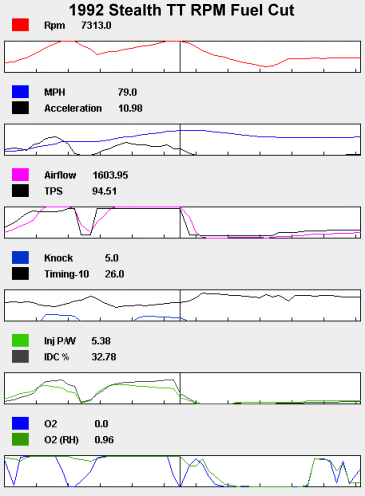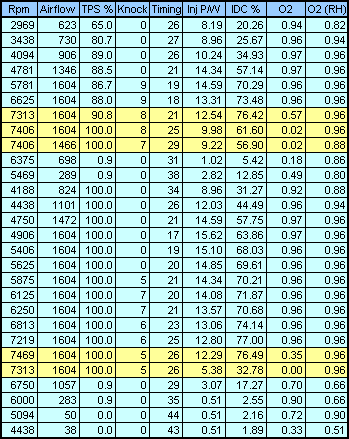Datalogging - Overrun-Protection Fuel Cut
by Jeff Lucius
Introduction
This datalog for my 1992 Dodge Stealth R/T Twin Turbo was collected on December 11, 2004 using a Palm m515 and the MMCd datalogging software. I manipulated the CSV file so that it could be input into PlViewer 2.01, a graphical viewer for PocketLOGGER log files. Right mouse click and save on this link to get this viewer: misc/plviewer2.zip. The portion of the datalog shown here is acceleration from a slow roll on the entrance ramp to a highway, with examples of overrun-protection fuel cut occuring above 7300 rpm in first and second gears.
The relevant engine modifications are: ARC2-GP hot-wire MAS conversion (with air temperature locked at 95º F and barometric pressure locked at 0.816 bar), A'PEXi S-AFCII (installed inline after the ARC2 controller), Denso 550 cc/min fuel injectors, re-wired Denso 195130-1020 fuel pump, TEC TD04-15G turbos, and Alamo/Cartech-type side-mount intercoolers. Maximum boost at WOT for this run was 17 psi.
Fuel Cut
When certain engine operating conditions occur, both open-loop and closed-loop fuel injection control are ignored and fuel delivery is shut off or reduced, that is, the ECU does not send the injector activation signals or it reduces the activation times. This is called fuel cut. There are three situations in which this occurs.
- The engine speed exceeds 7300 RPM (overrun protection).
- The A/N reaches or exceeds the prescribed value (overboost protection).
- The throttle plate is closed during engine deceleration above a certain speed.
Overrun protection.
Fuel is cut at 7300 RPM to prevent internal damage to the engine. The fuel activation signals are restored when engine speed falls below the threshold value. Adding a daughter board to the ECM can raise this threshold value. Our valvetrain is reported to be capable of 8000 to 8300 RPM without significant valve float or damage.
Overboost protection.
There is no sensor in the 3S cars to measure boost pressure. In 1996 and newer models there is a manifold absolute pressure (MAP) sensor, but it is used only for emissions purposes. The boost meter in the dash is a current-type meter that is controlled by the ECM. The ECM receives the air flow signal and engine speed signals and calculates the engine load. The boost meter is displaying the calculated A/N value rather than actual manifold absolute pressure. When the A/N exceeds a certain value at a particular RPM the ECM believes that excessive supercharging pressure exists and it stops sending the injector activation signals. Fuel flow resumes when the A/N falls below the threshold value. Note that overboost protection can occur at any RPM if the airflow is high enough (the threshold A/N changes over the RPM range). This overboost protection can be avoided by either reprogramming the ECM with a daughter board or by the use of an airflow signal conditioner (ASC) and larger fuel injectors. When larger fuel injectors are installed, the ASC reduces the airflow signal and the threshold value is rarely if ever exceeded.
Deceleration fuel cut.
Both emissions and fuel economy are adversely affected if fuel is delivered during closed-throttle deceleration at higher engine speeds. Therefore, the ECM does not send the injector activation signal during this situation. Once the engine slows, fuel delivery is resumed. The fuel cutoff speed and fuel resume speed depend on the coolant temperature, with both decreasing as coolant temperature increases.
Analysis of the Datalog
A Full Throttle Speed & Style Scanmaster 3 was connected to the diagnostic port. The Palm was connected to the Scanmaster 3 (2-scanmaster3-install.htm). The Scanmaster 3 sent vehicle speed (in mph) in place of ISC step data and vehicle acceleration (units unknown) in place of the acceleration enrichment data. The igition timing advance data as retrieved from the ECU and passed through to the Palm must have 10º subtracted to get the actual values the ECU is using. This is shown in the "Timing-10" graph and as "Timing" in the data spreadsheet. Timing advance values do not include the basic mechanical ignition timing advance set by the crank angle sensor (3º for my engine).
"TPS" and "TPS %" is the throttle position in percent (0% is closed, 100% is wide open). The "O2" values are voltages from the left-hand or rear bank oxygen sensor. The "O2 (RH)" values are voltages from the right-hand or front bank oxygen sensor. "Inj P/W" is the injector pulse width (IPW) in milliseconds. I think this is an average of the two IPWs used for two cylinder banks; I'll discuss this more below. "IDC %" is the injector duty cycle in percent (again an average of the two IPWs calculated as IPW x RPM / 1200).
The vertical bar in the graphical data is at the "7313 rpm" row in the second yellow section in the spreadsheet below.

The datalogged values for the two O2 sensors reveal how the ECU is cutting the fuel supply when engine speed exceeds 7300 rpm. The ECU first reduces the IPW for the rear (left-hand) bank until it is close to or reaches zero. If engine speed still exceeds 7300 rpm the ECU starts reducing the IPW for the front (right-hand) bank of cylinders. This is evident from the values in the yellow-highlighted spreadsheet cells for the rpm (above 7300), TPS (100% = WOT), rear O2 (going to 0 volts), and front O2 (remaining at 0.96 volts). Because I lifted the throttle to shift, the datalog cannot show at what engine speed the ECU restores fuel injection. However, the speed must be above 6750 rpm (O2 values after the second fuel-cut episode).
These episodes of overrun-protection fuel cut were accompanied by engine "sputtering". As shown in graph above, vehicle speed would not increase and acceleration reduced.

The ECU controls each fuel injector individually and each cylinder bank seperately. When the rear-bank O2 sensor shows near zero voltages, then fuel injection is not occuring or is near 0 milliseconds for that cylinder bank. However, IPW never aproaches zero in the yellow highlighted areas. This suggests the IPW displayed by this datalogger software is an average of the IPW for both banks. Because IDC is calculated using IPW, it also is an average. You can look at rows 553 to 581 in the CSV and XLS files below to see examples of IPW=0 and voltages=0 for O2 sensors of both banks (TPS%=9.41=closed on my engine) as the ECU is exhibiting deceleration fuel cut as explained above.
Additional information regarding fuel injection control for the DOHC 6G72 V6 in the Mitsubishi 3000GT and Dodge Stealth see my web page 2-fuelinjection.htm.
The CSV (comma-separated values) and XLS (MS Excel) files are available below. Note that the time values are not the original values. The time data must be formatted a certain way for input into PlViewer, so I copy these from a PocketLOGGER file. Also, column titles are changed to match those expected by PlViewer. PlViewer is a Java "jar" compressed file. A Java runtime environment (JRE) must be installed to run this program (see http://java.sun.com/j2se/). Just double click on the JAR file to start the software.
http://www.stealth316.com/misc/12_11_04-14_39_05_-_GFMS.csv
http://www.stealth316.com/misc/12_11_04-14_39_05_-_GFMS.xls
Page last updated December 13, 2004.


